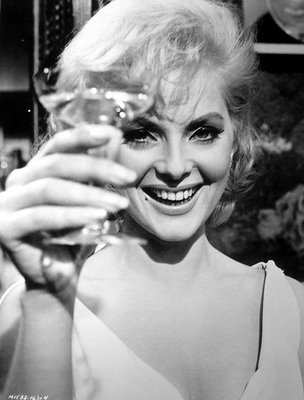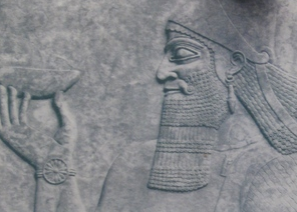 THE LAST TIME I SAW Italian actress Virna Lisi she was having a wonderful time vamping it up as a reptilian Queen Catherine de Medici in the 1994 film adaptation of the Alexandre Dumas potboiler La Reine Margot. The photo at left I take to be from her 1965 Hollywood film, How to Murder Your Wife.
THE LAST TIME I SAW Italian actress Virna Lisi she was having a wonderful time vamping it up as a reptilian Queen Catherine de Medici in the 1994 film adaptation of the Alexandre Dumas potboiler La Reine Margot. The photo at left I take to be from her 1965 Hollywood film, How to Murder Your Wife.
Together the smile, the eye-contact, the raised glass comprise an ensemble of gestures instantly recognizable as a toast, a ritual so intimately linked to wine drinking that its origins are shrouded in the mists of pre-history. What we can say for sure is that by the time something like a culture of wine can be discerned in the archaeological/ art history record, the toast has already assumed a character we recognize.
 Consider the ancient Assyrian prince at right, resplendent in his cornrows and intricately braided beard who seems as fully at home with the practice as Ms. Lisi. The same lifted cup of wine and focused gaze; the hint, perhaps, of a smile. The juxtaposition of 1960’s Italian film star and ancient monarch is almost eerie – as if the millennia separating them had melted away and each were transfixed by the gaze of the other. “I’m about to drink,” the royal in this 8th century BCE bas relief seems to say. “You drink, too.”
Consider the ancient Assyrian prince at right, resplendent in his cornrows and intricately braided beard who seems as fully at home with the practice as Ms. Lisi. The same lifted cup of wine and focused gaze; the hint, perhaps, of a smile. The juxtaposition of 1960’s Italian film star and ancient monarch is almost eerie – as if the millennia separating them had melted away and each were transfixed by the gaze of the other. “I’m about to drink,” the royal in this 8th century BCE bas relief seems to say. “You drink, too.”
So deeply imbued are we with the notion of the toast as a friendly gesture conveying good-will, esteem, even affection that it’s easy to lose sight of what was very likely responsible for the emergence of the practice in the first place: the danger associated with undisciplined group drinking.
The problem is apparent. In a group where the pace of drinking isn’t supervised a situation will quickly develop in which some are inebriated while others remain sober – a state in which those operating under the influence are at a distinct disadvantage. For some to retain the full use of their wits even as others slid into oblivion posed a clear threat.
To address this risky situation we invented the regulated drinking party at which the company indulges enthusiastically but always reciprocally and symmetrically. All drink together, glass for glass, at a measured pace that ensures both parity of blood-alcohol and a degree of safety for all involved. Drinking proceeds in rounds: As I drink you drink, too.
It’s the essence of a toast to serve both as a cue that another round is about to go down and as a call for everyone to participate in it. To fail to join in was to be delinquent in the social drinking contract and risk falling outside the pale of civilized behavior. Only barbarians swilled wine just as they pleased with no regard for due order or the direction provided by an experienced toastmaster. (Note: I wrote about the most strictly regulated drinking regime of all, the classical-era symposium, here, last year.)
It’s the essence of a toast to serve both as a cue that another round is about to go down and as a call for everyone to participate in it.
Participation in this ritual was more than a signal that you were with the program, on the bus. It was a pledge of full engagement, good-faith, and honest intention. The practice proved very long-lived. Until well into the 20th century it was common among all classes (in the West, at least) to seal agreements and settle disputes with a shared drink. In many societies it’s still the norm. The deal isn’t done (or the hatchet buried) until the glasses clink.
But if the toast had to depend solely on its pacing or deal-making skills to justify its existence it would likely have long since been trundled off to the junkyard of discarded rituals. There’s another bit to be reckoned with. The lifted glass is traditionally accompanied by speech, often short and simple (Bottoms up! Cin Cin!) but occasionally more elaborate – an apt quotation, a few lines of verse, perhaps even something approaching a mini oration.
One of the things a toast does better than almost anything else I can think of is give people an opportunity (excuse?) to say things they may be too shy to say in the ordinary course of things: the very simple but important things that may go unsaid for want of a situation where saying such things seems appropriate.
It’s why at our table we try to see that no drink goes down – be it ever so humble – without citing the occasion, noting an achievement, acknowledging a happiness (or, lacking one, doing our best to wish one into existence). A toast is an invitation to celebrate a victory, share a hope, voice a commitment. It’s an all-around lovely habit to cultivate, I think. It’s certainly one that makes a strong connection to the generations of wine drinkers who have come before.
And if you’re feeling a little awkward or tongue-tied at first, remember that one of the things a glass of wine is there to do is lend its mystic aura of warmth, grace, and gravitas to whatever we have to say .
I’ll clink to that. How about you?